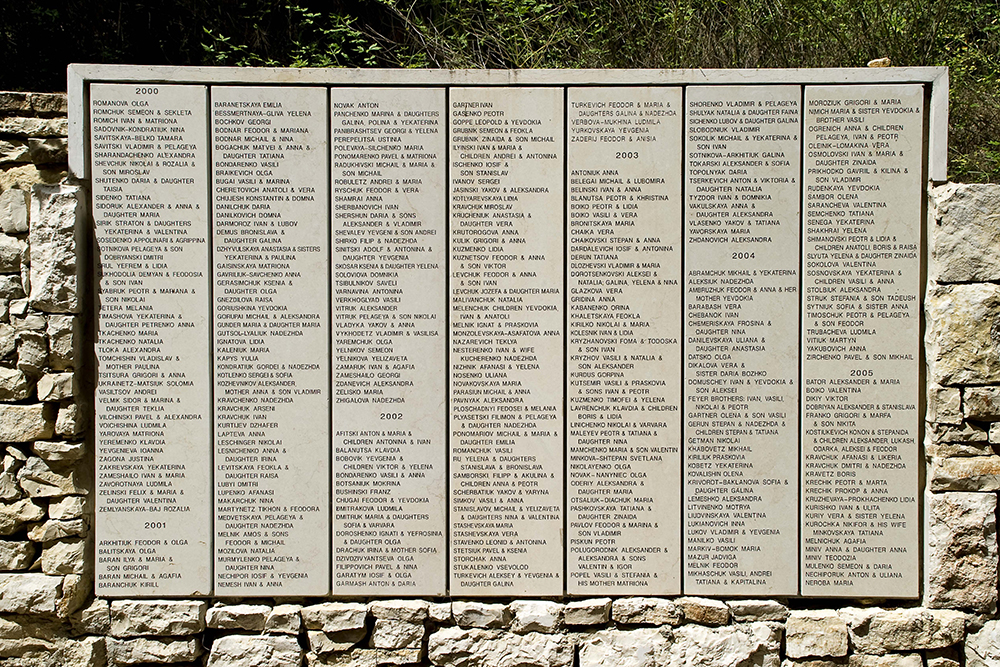Bank of Portraits / Lomakina Vira and Tymofieieva Valentyna

Vira Lomakina and Valentyna Tymofieieva
Vira Lomakina and Valentyna Tymofieieva were schoolmates and lived in Mariupol, Stalino (now Donetsk) region. They were acquainted with Moisei Shvartsberh and his family – his Ukrainian wife Anastasiia, daughters Marharyta and Halyna, and Moisei’s mother Esfir.
On October 8, 1941, Mariupol was occupied by German troops. Soon, according to the order of the commandant of the city, a list of Jewish residents of Mariupol was compiled. On October 18, all around the city, the citizens found leaflets, which ordered all the listed residents to come to the so-called regiment (the headquarters and barracks of the former 238th Mariupol Rifle Regiment of the 80th Rifle Division (now the building of Pryazovskyi Technical University) on October 20 at 08:00. It was also ordered to take documents, some food, clothes and valuables. Those who disobeyed the order had to be executed.
Moisei went to the collection point alone. And did not come back.
On the morning of October 20, columns of Jews, escorted by machine gunners and motorcyclists, were driven to the village of Ahrobaza (6 km west of the city) to the anti-tank trenches. Some of them realized what awaited them, but it was impossible to change the situation. Some Jews pushed their children into the crowds standing by the side of the road. At the risk of their own lives and the lives of their loved ones, local women rescued those kids. The execution of the Jews lasted two days. They were taken out of the barns in groups, forced to undress, to stand over a ditch and then were shot. Those who managed to survive tried to get out of the ditch after dark, went to the nearest villages and asked for help from the locals.
In a few days of October 1941, the Sonderkommando 10a shot dead from 8,000 to 12,000 Mariupol Jews in Soviet anti-tank trenches. Throughout the period of German occupation, anti-tank trenches near the village of Ahrobaza were used not only to shoot the Jews, but also to execute communists, underground fighters, and workers who refused to work for the Germans.
When the citizens learnt about the shootings, Esfir realized that she and her granddaughters had to escape. 14-year-old Vira Lomakina was the one who rescued them. She helped the Shvartsberhs to get to her aunt Marta in Bezimenne village, on the coast of the Azov Sea. The Jewish family lived in a cellar for almost two months. Marta did not tell anyone about the fugitives, but later the neighbors noticed the “guests” and began to demand that the hostess expel them. When it became dangerous for the Jews to stay there, Vira asked her friend Valentyna Tymofieieva to help with the shelter. For several weeks Marharyta and Halyna Shvartsberh and Esfir hid at Valentyna’s grandmother’s place in the village of Sadky (now Boikivskyi district of the Donetsk region). Later, their mother's brother Vasyl Potapov and his wife Yevdokiia helped to rescue the girls. The Jews were settled in an abandoned dugout near the Sartana railway station (northern outskirts of Mariupol). Late in the evening, rescuers brought food and water to the dugout. Vira and Valentyna also did not forget about eight-year-old Marharyta and four-year-old Halyna, tried to cheer them up, visited them in turns. They spent almost two years of occupation together, experiencing hunger, cold, and fear.
After the war, the girls’ ways parted. Halyna Shvartsberh later moved to Israel. Many years later, Valentyna and Vira were found by Marharyta Shvartsberh-Zholobova, who was living in Luhansk at that time.
On November 3, 2004, Yad Vashem awarded Vira Oliynyk (Lomakina) and Valentyna Liudvynska (Tymofieieva) the title of "Righteous Among the Nations."

Mariupol Museum of Local History
Mariupol
-
fingerprintArtefacts
-
theatersVideo
-
subjectLibrary
